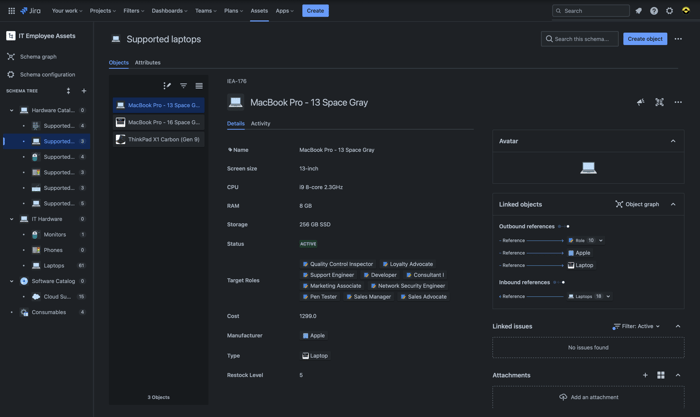Today, we're exploring Atlassian's solution for tracking your organization's valuable assets digitally: Atlassian Assets, formerly called "Insight Asset Management". Remember, we are defining assets as anything that helps you get work done: lab equipment, computer hardware, cloud infrastructure, mobile devices, software/SaaS licenses, tools, work stations, furniture, etc.
In our industry, digital asset management is usually thought of as a component of "service management." Service management was traditionally considered an IT function (often manifested in the form of an IT help desk). In recent years, however, we have been implementing these practices across the organization—from legal to human resources to finance—because they dramatically increase the speed and quality of how work flows.
Leveraging Asset Management Across the Organization
This expansion of service management practices beyond the IT organization means more teams are taking advantage of Atlassian's asset management tool, Atlassian Assets. The impact of this trend is often quite remarkable as processes are formalized, streamlined, and consistently monitored. Teams using Atlassian Assets get additional process benefits. Unlike inflexible, legacy Configuration Management Databases (CMDBs), Atlassian Assets uses an open data structure which allows your teams to manage any resource important to their service requests. Including assets in your service management practices is a big step forward.
Think about how work gets done in any part of your organization: your process workflows. It typically starts with the (internal or external) customer submitting a service request, like a new employee onboarding, a facility request, a contract review, etc... The request is picked up from the queue by an agent who will take actions to move the work forward to resolution. Many actions may be needed along the way: obtaining additional information, forwarding to another team, making a configuration change, creating an account, procuring a requested item, repair equipment, provide updates back to the requester, etc. These actions are all turbo-charged and made easier through Jira's functionality and built-in fields. But is there something missing? Yes, assets! Almost every request involves procuring, repairing, replacing, upgrading, decommissioning, or dealing with assets in some way. A Jira issue, by default, doesn't include fields to track data related to these items.
Deep Integration Between Assets, Issues, and People
We could employ custom fields to create a drop-down list of assets, but we quickly run into limits with this approach. As discussed in the former post, assets usually have many attributes, such as serial numbers, vendor/service contacts, documentation, relationships to other assets, etc... There's no way to stuff all of this information into a custom field. Using multiple custom fields is cumbersome for agents and for reporting/tracking due to data entry accuracy issues. In addition, we can't establish relationships between assets represented in custom fields; these are important for being able to see all assets located in a certain location or seeing what other assets will be impacted by removing or changing an asset, for example. We need an integrated solution that's tailored to managing our assets within Jira tickets.

Atlassian Assets enhances operational efficiency by linking issues to dynamic asset records, providing a comprehensive view of your assets. But the real value comes in how it drives seamless workflow across your organization. With Atlassian Assets managing your assets, we unlock the ability to automate ticket assignment based on asset attributes like location, model, or vendor. This removes the need for manual reassignment and reduces resolution time, keeping your teams focused on high-value tasks. Automated alerts ensure the right stakeholders—whether safety or engineering teams—are notified in real time when critical issues arise. Additionally, automated discovery supports audit and compliance needs, providing an accurate picture of the assets supporting your operations. Atlassian Assets offers unmatched flexibility, helping organizations maintain clarity and streamline processes.
Are your assets managing you instead of the other way around? If so, get in touch, and let's apply the power of Atlassian Assets to your business.
